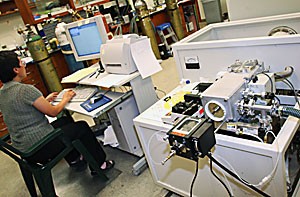UA chemistry and biochemistry researchers are giddy about a big new machine.
The university will buy a new mass spectrometer this year, thanks to a $924,995 grant from the National Institutes of Health, Vicky Wysocki, professor of chemistry and biochemistry, wrote in an e-mail.
The Fourier Transform Ion Cyclotron Resonance Mass Spectrometer will provide a high level of precision in the study of the composition, structure and behavior of complex molecules, especially proteins, solidifying the UA’s position at the forefront of mass spectrometry and proteomics research, said Tom Baldwin, head of the biochemistry and molecular biophysics department.
Graduate and undergraduate students, as well as researchers from other departments and institutions, will have access to the new equipment to conduct research on toxicology, cancer, the atmosphere of Saturn’s largest moon, Titan, and other fields, Wysockiwrote.
“”(This) particular instrument allows a large number of experiment types and will allow us to develop experiment types that may be useful to other users around the world,”” she wrote.
A mass spectrometer operates by breaking molecules into electrically charged fragments called ions. Then it sorts those fragments by their mass using a magnetic field, said Roger Haar, laboratory manager of the physics department.
In biochemistry, mass spectrometry may by used to reveal small but significant structural changes in a protein or protein fragment that lead to diseases like cancer. The shape of the proteins in a healthy tissue sample can be compared to that of diseased tissue, offering insight into the fundamental nature of an illness, Baldwin said.
“”These instruments are extremely flexible,”” Wysocki wrote. “”They allow chemical reactions inside.””
Weighing more than 12,000 pounds, Wysocki said the FTICR employs technology similar to that used in magnetic-resonance imaging machines. It features an actively shielded, refrigerated superconducting magnet capable of producing a 9.4-Tesla magnetic field – that’s nearly 200,000 times stronger than the Earth’s natural magnetic field, according to the National Oceanic and Atmospheric Administration’s online magnetic field calculator.
A photo of the apparatus depicts a white cylindrical chamber containing the magnet, standing more than 6 feet high and capped with stainless steel high-vacuum flanges. Next to it sits a large white rectangular box resembling a mutant photocopier.
Most people don’t know that chemistry can be done with gases, Wysocki wrote. “”By the time you combine all the different activation methods and chemical reactions, then you have a powerful chemical reaction device.””
Wysocki wrote that the machine would probably be installed in the Old Chemistry building, 1306 E. University Blvd., in December.
While conducting an experiment involving an existing FITCR, Stephanie Shu, assistant staff scientist in the chemistry department, said that the new machine would benefit researchers with its enhanced resolution and accuracy.









